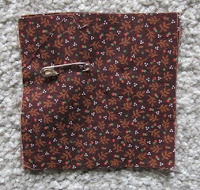Recently I was finishing the edges of a small quilt. I was using the facing technique instead of binding because there was not enough of my border fabric to make binding strips.
As I was inspecting the edges of the quilt, I saw that one corner antique block had a slit along an edge. I thought that my walking foot took a wide enough seam allowance that the slit would be enclosed. All would be okay.
But it was not okay. It wasn't until I had all of the facing turned to the back side that I discovered the batting poking out of that corner. Now what? This project was set aside as I pondered how to fix this problem.
Several other quilts were waiting for bindings, so I set to work on one of them. I chose a tan fabric with which to bind a charity lap quilt. The binding strips were joined in the usual way--perpendicular to one another--so there were small triangle pieces to cut away from the seam allowances.
Hmmm...could one of these triangles be used to fix the problem with the other quilt? The fabric was a good color, but would the size work?
The facing was undone in that corner area and a triangle basted in place. There was enough seam allowance along the diagonal edge to turn under. That allowed me to applique the triangle in place, over the damaged original corner of the block.
The facing was reworked in that area, and one would never know that a repair had been made!
Another use for a cut-away triangle. :)
































